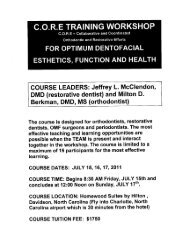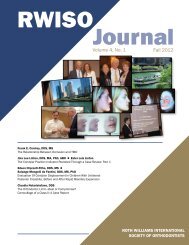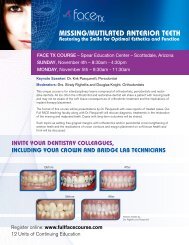2010 RWISO Journal - Roth Williams International Society of ...
2010 RWISO Journal - Roth Williams International Society of ...
2010 RWISO Journal - Roth Williams International Society of ...
You also want an ePaper? Increase the reach of your titles
YUMPU automatically turns print PDFs into web optimized ePapers that Google loves.
All available intraoral photographs that had been taken<br />
in the past were put together to analyze the event <strong>of</strong> tooth<br />
wear in this patient (Figure 13).<br />
Figure 13 The event <strong>of</strong> upper canine wear during orthodontic<br />
treatment. The right canine shows definite wear (red arrows)<br />
during fixed-appliance therapy. The sharp anatomy (blue circle)<br />
<strong>of</strong> the left canine tip at the time <strong>of</strong> eruption is shown in the<br />
photograph (May 2000). It was gone before the<br />
fixed-appliance therapy.<br />
The upper right canine showed no wear before the<br />
initial stage <strong>of</strong> fixed-appliance therapy in June 2001. The<br />
canine wear occurred sometime during the following 8<br />
months, and further wear seemed to have occurred between<br />
February 2002 and December 2002. The upper left canine<br />
erupted with sharp anatomy in May 2000. However, the tip<br />
was worn down already on the day <strong>of</strong> bracket bonding, and<br />
the wear progressed during the fixed-appliance therapy. In<br />
the absence <strong>of</strong> anatomy at the cusp tips and incisal edges, as<br />
in Figures 3-c and 3-e, proper anterior guidance and canine<br />
guidance in movement would not have taken place (Figure<br />
14). This in turn would have caused further wear with the<br />
passage <strong>of</strong> time, as shown in Figures 6 and 7. 10<br />
Figure 14 Mandibular movement <strong>of</strong> the mounted models.<br />
Figure 14-a Intraoral movement shown in Figure 5-a was<br />
reproduced with models mounted on a semiadjustable<br />
articulator in SCP. There were nonchewing-side interferences<br />
<strong>of</strong> the functional cusps <strong>of</strong> the upper left molars (red arrows).<br />
Figure 14-b Intraoral movement shown in Figure 5-b was reproduced<br />
using models. There were nonchewing-side interferences<br />
<strong>of</strong> the functional cusps <strong>of</strong> the right upper molars (red arrows).<br />
Stable condylar position (SCP) could not be recorded in<br />
the presence <strong>of</strong> dysfunction <strong>of</strong> the masticatory system, 11 so<br />
a maxillary anterior-guided orthosis12 was prepared and the<br />
patient wore it for 2 months, until all clinical signs and symptoms<br />
<strong>of</strong> TMJ dysfunction disappeared. The orthosis (Figure<br />
15) allowed the condyles to assume their superior, anterior,<br />
and medial (SAM) positions in intimate contact with the<br />
thinnest part <strong>of</strong> the biconcavity <strong>of</strong> the disc, and made possible<br />
the diagnosis <strong>of</strong> a SCP from the maximum intercuspal<br />
position (MIP). The SCP was recorded with Axi-Path recording,<br />
so the mounted models would arc close in centric. 13,14<br />
Figure 15 Maxillary anterior guided orthosis. The patient<br />
wore the removable plate continuously until all the<br />
symptoms disappeared and SCP was obtained.<br />
<strong>RWISO</strong> <strong>Journal</strong> | September <strong>2010</strong><br />
65








